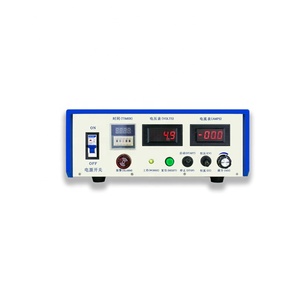
All categories
Featured selections
Trade Assurance
Buyer Central
Help Center
Get the app
Become a supplier

(2463 products available)












Electroplating equipment for lab refers to the apparatus used in laboratories for the electroplating process. This equipment is usually smaller than those used in industries. It often includes a power supply, plating tank, heaters, filtration pumps, anodes, cathodes, fume extraction systems, and other accessories.
The apparatus used for electroplating in a lab is not much different from what is available on an industrial scale. However, the size and the amount available are limited for lab use. Some of the equipment that is used in the electroplating process is as follows:
Equipment for electroplating in lab comprises multiple compopents where each corresponds to unique specifications. Common equipment specs include the size, voltage, and amperage.
Size
Generally, electroplating equipment for lab comes in small to moderate sizes to fit in different research and manufacturing environments. The design is for ease of use by one or a few people at a given time. In most cases, dimension is always less than 6 fee tall and 3 fee wide.
Voltage
The voltage for electroplating machine is low. It ranges from 1.5 to 12 volts to ensure maximum safety during the plating process. Lower voltage minimizes the risk of electric shocks on the operator.
Amperage
Amperage in lab equipment is variable depending on the size of the object being plated and the type of metal. However, it is always kept at a low level to avoid overheating of the plating bath and the power supply. It is normally less than 10 amperes.
Proper maintanence ensures the electroplating machine serves its purpose for a longer time and consistently delivers quality plating results. Regular maintenance of the equipment can lengthen its lifespan, reduce the need for most frequent replacements, and lower the repair costs.
Regular Cleaning
Manufacturers recommend cleaning the plating tanks regularly. This prevents the build-up of any foreign material that can compromise the quality of plating.
Only appropriate chemicals should be used to clean the equipment. The determined cleaning agents will not react with the plating solution or any part of the equipment.
Routine Maintenance
Operators should schedule routine maintenance for the electroplating machine. This maintenance helps to identify the areas that need repair or servicing. It allows for the abnormal situations to be fixed before they turn into bigger problems. In most cases, they can cause lengthy equipment downtime and costly repair procedures.
Proper Handling
Proper handling of the electroplating equipment, especially the delicate components, is very crucial. It helps to avoid any damage and maintain the functional integrity of the machine.
The Electroplating equipment has various application scenarios in different industries.
Metal Surface Treatment:
Electroplating equipment is used by metal manufacturing, machinery, auto parts, hardware, and instrument manufacturing industries to apply metal coatings to workpieces like metal parts and hardware, thereby improving their surfaces' resistance to wear, corrosion, high temperatures, and fatigue.
Jewelry and Decorative Item Plating:
Jewelry, decorative items, and related accessories manufacturers apply electroplating equipment to coat precious metals like gold and silver on base metals. This not only enhances the items' aesthetic appeal but also increases their value.
Electronic Component Plating:
Electroplating equipment is used by electronics manufacturers to enhance the conductivity and solderability of electronic components like connectors, switches, and circuit boards by applying coatings of materials like gold, silver, or copper.
Plastic Parts Electroplating:
Plastic parts electroplating equipment is used to deposit a metal layer on plastic substrates in the automobile, electronics, home appliance, and decorative industries. It improves mechanical properties like strength, abrasion resistance, and temperature resistance and enhances aesthetic qualities such as brightness, smoothness, and adhesion.
Medical Device Plating:
Medical equipment and device manufacturers use different types of electroplating equipment to assist in the production of medical devices used for diagnosis, treatment, monitoring, and rehabilitation. These devices must be accurate, reliable, and biocompatible, and they need to comply with medical device regulations.
Automotive Component Plating:
Automobile manufacturing industries apply electroplating to enhance the beauty and aesthetics of automotive components. It improves the quality and appearance of automotive parts like grilles, mouldings, and wheels for higher market share and customer satisfaction.
Research and Development:
Electroplating equipment is commonly used in the research and development labs of various industries. They use electroplating in their experiments to study the electroplating process, optimize plating solutions, and develop new electroplating techniques.
Purchasers should consider several factors before buying lab electroplating equipment.
Q1: What is the function of the electroplating lab equipment anode?
A1: The anode of electroplating lab equipment is typically made of the same metal intended to be deposited on the workpiece. Its primary role is to supply metal ions to the solution through its gradual dissolution during the plating process.
Q2: Why is voltage monitored in electroplating lab equipment?
A2: Voltage is monitored in electroplating lab equipment because it is crucial in determining the plating rate and the quality of the deposit. Higher voltage may increase the plating rate but can also lead to coarser deposits and increased chances of throwing power. If the voltage is too low, the plating process may be slow and inefficient.
Q3: Why is control important in electroplating lab equipment?
A3: Control is essential in electroplating lab equipment because it allows for maintaining the plating solution's temperature, pH, and chemical concentration. This facilitates a consistent deposition rate, high-quality deposits, and efficient plating.
Q4: What are some common lab electroplating solutions?
A4: Some common lab electroplating solutions include copper sulfate for copper electroplating, nickel sulfate for nickel electroplating, gold chloride for gold electroplating, silver cyanide for silver electroplating, and zinc sulfate for zinc electroplating.
Q5: What is the role of the cathode in electroplating lab equipment?
A5: The workpiece is often referred to as the cathode in electroplating lab equipment. The metal ions in the electroplating solution are attracted to the workpiece. They are then deposited onto its surface during the electroplating process.